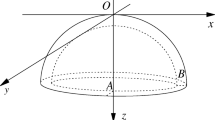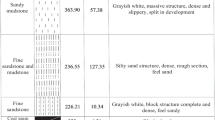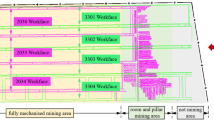Abstract
With an increasing number of multi-seam mining projects, the problem of strata movement caused by multi-seam mining has attracted increasing attention. Previous studies have shown that the rock failure mechanism for multi-seam mining is obviously different from single-seam mining. When a lower coal seam is being mined, two issues are apparent: the activation that the upper goaf will suffer and the difference in the break mechanism of the stratum between single-seam and multi-seam mining. The research regarding these two issues is still inadequate. In this paper, a physical model experiment was used to simulate the full longwall mining process of multiple seams. Then, the failure mechanics of the stratum and the influence of mining the lower coal seam on the activation of the upper goaf are discussed under the condition that the upper coal seam has been fully mined. The results show that a part of the fracture zone that formed by mining the upper coal seam will be converted into a caving zone when the lower coal seam is mined. In multi-seam mining, the cracks in the overlying fractured rock mass will widen and propagate upward. During the process of mining the lower coal seam, the interburden rock mass presents a typical plate bending failure, and the break location is greatly affected by the distribution of the periodic weighting in the upper coal seam mining. Multi-seam mining will cause the surface subsidence trough produced by upper coal mining to move towards the end of the mining panel. The mechanism of rock stratum movement revealed by the test has a certain practical guidance for the control of roof pressure in multi-seam mining and the subsidence of surface.













Similar content being viewed by others
References
Adhikary D, Khanal M, Jayasundara C, Balusu R (2015) Deficiencies in 2D simulation: a comparative study of 2D versus 3D simulation of multi-seam longwall mining. Rock Mech Rock Eng 49(6):2181–2185
Ghabraie B, Ren G, Zhang X, Smith J (2015) Physical modelling of subsidence from sequential extraction of partially overlapping longwall panels and study of substrata movement characteristics. Int J Coal Geol 140:71–83
Ghabraie B, Ghabraie K, Ren G, Smith JV (2016) Numerical modelling of multistage caving processes: insights from multi-seam longwall mining-induced subsidence. Int J Numer Anal Met 41(7):959–975
Ghabraie B, Ren G, Smith JV (2017a) Characterising the multi-seam subsidence due to varying mining configuration, insights from physical modelling. Int J Rock Mech Min 93:269–279
Ghabraie B, Ren G, Barbato J, Smith JV (2017b) A predictive methodology for multi-seam mining induced subsidence. Int J Rock Mech Min 93:280–294
Helm PR, Davie CT, Glendinning S (2013) Numerical modelling of shallow abandoned mine working subsidence affecting transport infrastructure. Eng Geol 154:6–19
Iwanec AMS, Carter JP, Hambleton JP (2016) Geomechanics of subsidence above single and multi-seam coal mining. J Rock Mech Geotech Eng 8(3):304–313
Khanal M, Adhikary D, Jayasundara C, Balusu R (2015) Numerical study of mine site specific multiseam mining and its impact on surface subsidence and chain pillar stress. Geotech Geol Eng 34(1):217–235
Lin N, Sasaoka T, Shimada H, Hamanaka A, Matsuia K (2013) Numerical analysis of interaction effects in double extra-thick coal seams mining. Proc Earth Planet Sci 6:343–349
Liu X, Tan Y, Ning J, Tian C, Wang J (2015) The height of water-conducting fractured zones in longwall mining of shallow coal seams. Geotech Geol Eng 33(3):693–700
Ma WJ, Hu HF (2013) The strata movement regularity and parameter simulation analysis in multiple seams repeated mining. Appl Mech Mater 295–298:2935–2939
Ma WM, Zhu WY (1984) Effect of multi-seam mining on subsidence. Int J Min Eng 2(2):171–173
Miao X, Cui X, Wang JA, Xu J (2011) The height of fractured water-conducting zone in undermined rock strata. Eng Geol 120(1–4):32–39
Porathur JL, Srikrishnan S, Verma CP, Jhanwar JC, Pal Roy P (2014) Slope stability assessment approach for multiple seams highwall mining extractions. Int J Rock Mech Min 70:444–449
Ren G, Li G, Kulessa M (2014) Application of a generalised influence function method for subsidence prediction in multi-seam longwall extraction. Geotech Geol Eng 32(4):1123–1131
Salmi EF, Nazem M, Karakus M (2017) Numerical analysis of a large landslide induced by coal mining subsidence. Eng Geol 217:141–152
Suchowerska AM, Merifield RS, Carter JP, Clausen J (2012) Prediction of underground cavity roof collapse using the Hoek-Brown failure criterion. Comput Geotech 44:93–103
Suchowerska AM, Merifield RS, Carter JP (2013) Vertical stress changes in multi-seam mining under supercritical longwall panels. Int J Rock Mech Min 61:306–320
Sui W, Hang Y, Ma L, Wu Z, Zhou Y, Long G, Wei L (2014) Interactions of overburden failure zones due to multiple-seam mining using longwall caving. B Eng Geol Environ 74(3):1019–1035
Tang CA, Yang WT, Fu YF, Xu XH (1998) A new approach to numerical method of modelling geological processes and rock engineering problems—continuum to discontinuum and linearity to nonlinearity. Eng Geol 49(3–4):207–214
Tian C, Yang X, Sun H, Liu Y, Hu Q (2019) Experimental study on the overburden movement and stress evolution in multi-seam mining with residual pillars. Energy Sci Eng 7(6):3095–3110
Tulu IB, Esterhuizen GS, Klemetti T, Murphy MM, Sumner J, Sloan M (2016) A case study of multi-seam coal mine entry stability analysis with strength reduction method. Int J Min Sci Technol 26(2):193–198
Wang DC, Yang YJ, Wang K, Zhao NN (2012) Numerical simulation of study on rupture development rules of overburden strata in repeated mining. Adv Mat Res 433–440:1933–1939
Wang G, Wu M, Wang R, Xu H, Song X (2017) Height of the mining-induced fractured zone above a coal face. Eng Geol 216:140–152
Wei X-Q, Bai H-B, Rong H-R, Jiao Y, Zhang B-Y (2011) Research on mining fracture of overburden in close distance multi-seam. Proc Earth Planet Sci 2:20–27
Ying-ke L, Fu-bao Z, Lang L, Chun L, Shen-yong H (2011) An experimental and numerical investigation on the deformation of overlying coal seams above double-seam extraction for controlling coal mine methane emissions. Int J Coal Geol 87(2):139–149
Zhang Y, Yan L (2015) Experimental study on distribution law of residual fissure under multiple mining conditions. Revista de la Construcción J Constr 14(1):77–81
Zhang M, Shimada H, Sasaoka T, Matsui K, Dou L (2013) Evolution and effect of the stress concentration and rock failure in the deep multi-seam coal mining. Environ Earth Sci 72(3):629–643
Zhang X, Ghabraie B, Ren G, Tu M (2018) Strata movement and fracture propagation characteristics due to sequential extraction of multiseam longwall panels. Adv Civil Eng. https://doi.org/10.1155/2018/4802075
Zhu D, Tu S (2017) Mechanisms of support failure induced by repeated mining under gobs created by two-seam room mining and prevention measures. Eng Fail Anal 82:161–178
Zhu Z, Zhang H, Nemcik J, Lan T, Han J, Chen Y (2018) Overburden movement characteristics of top-coal caving mining in multi-seam areas. Q J Eng Geol Hydrogeol 51(2):276–286
Acknowledgements
This research is supported by the National Natural Science Foundation of China (Nos. 41772326).
Author information
Authors and Affiliations
Corresponding author
Additional information
Publisher's Note
Springer Nature remains neutral with regard to jurisdictional claims in published maps and institutional affiliations.
Rights and permissions
About this article
Cite this article
Qin, Y., Xu, N., Zhang, Z. et al. Failure Process of Rock Strata Due to Multi-seam Coal Mining: Insights from Physical Modelling. Rock Mech Rock Eng 54, 2219–2232 (2021). https://doi.org/10.1007/s00603-021-02415-0
Received:
Accepted:
Published:
Issue Date:
DOI: https://doi.org/10.1007/s00603-021-02415-0




